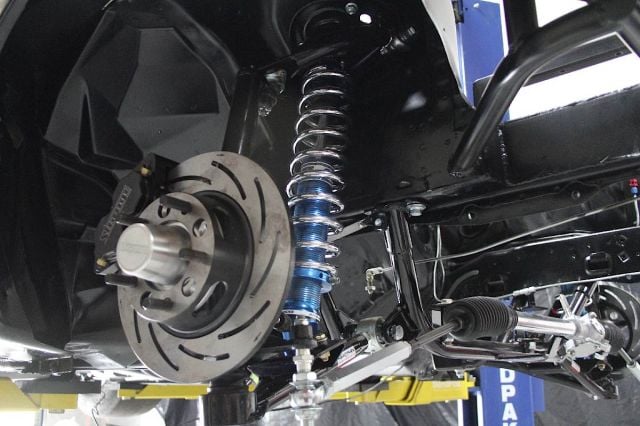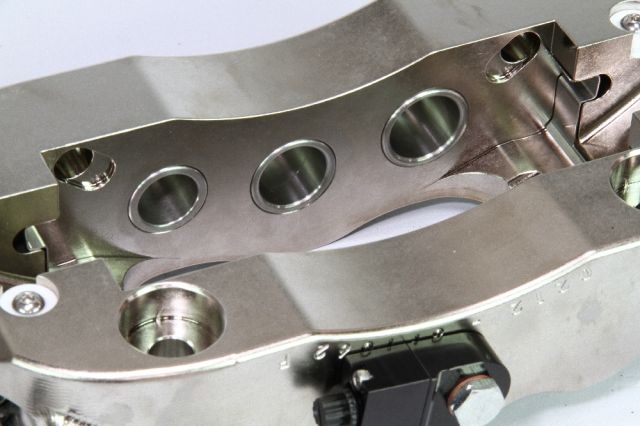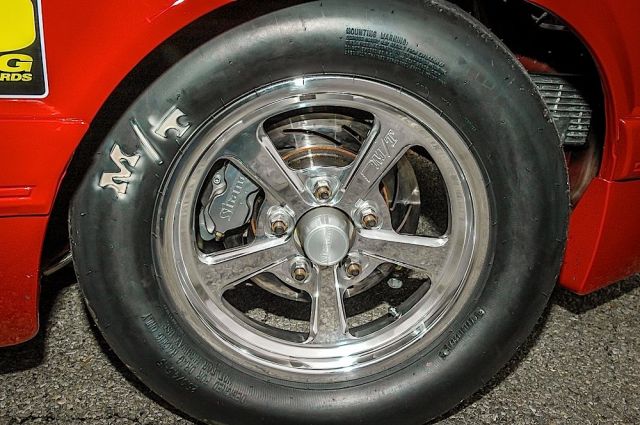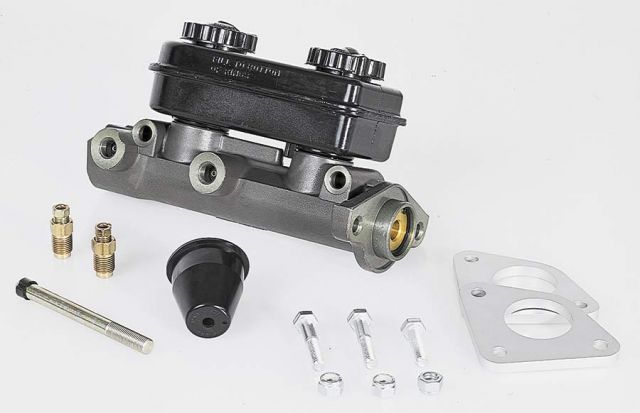
As important as horsepower is to propelling your car down the track and getting a win light, brakes are equally important in making sure you stop safely and get back to the pits. Many racers will give little thought to those brakes until the time comes that they actually have to rely on them. This could be anywhere from the first run in a new setup that is significantly faster than what the driver is accustomed to, to an emergency situation such as failure of the parachutes to deploy or avoiding a crash.

Street car systems are fine for just that, street cars, and the occasional blast on test and tune night down the strip. Serious racers need a serious brake system that can handle the heat and braking load demands of stopping a race car at high speeds.
Many racers who are new to the sport may stick to their stock brakes, thinking they’re adequate. The problem with OEM brakes is that they are designed for everyday street situations and not rapid acceleration to deceleration situations. Unless you’re driving a high-end super car, chances are the braking system is not designed to pull in the reins on those high speed blasts. OEM brakes are often very heavy as well, and drag brakes thus provide a significant savings in weight over a street car system if your car is only making dedicated trips down the track.
In this tech feature, we’ll take a deeper look at the various offerings for street/strip brake systems and the how and why, piece by piece, of the benefits a street/strip drag brake system can deliver to your ride in the name of safety and stopping power. To help us accomplish this, we’ve sat down with some of the most influential names in the drag brake market, including Moser Engineering’s Tim Irwin, Strange Engineering’s JC Cascio, and Baer’s Gabi Baer.
Rotors
Typical OEM passenger car brake rotors are made from cast iron, a material that better tolerates the heat cycling of the daily grind traffic that most of us experience. OEM cast iron rotors are designed, in most cases, with cooling fins to provide adequate cooling in those situations involving regular use and frequent heat cycling. Street car brakes also use a parking brake system, which is something not required in most race cars.

Large OEM style rotors like this are excellent for high performance cars driving on the street. These rotors though may fail due to thermal shock when stressed under the high speed and high heat demands of stopping a car after a pass at the drag strip.
Most street car brake systems are adequate for mild drag racing – the kind of trip you might make on a Friday night or even a street-driven, style-track event.
Brake offerings for street cars run the gambit from stock offerings all the way up to massive six piston designs, with pizza pan-sized rotors that provide great clamping and stopping power on today’s high powered muscle cars.
OEM Rotor Issues on the Track
According to J.C. Cascio of Strange Engineering, the problem with OEM cast iron rotors is that they can experience thermal shock, “This occurs in drag racing when your brakes will typically go from being near ambient temperature at the starting line to red hot as you apply them after crossing the finish line. This rapid cycle of hot to cold can cause any number of problems with the rotors. The faster your trap speeds are, the greater the thermal shock. Problems occur as the rotor is rapidly heated to and often beyond it’s maximum designed operating temperature. Warping, cracking, and the worst case scenario of the actual shattering of the rotor can all occur with a cast iron rotor that is subjected to frequent thermal shock.”
Weight is yet another factor that comes into play with OEM type rotors. Brake rotors are one of the biggest contributors to the total brake system weight. Those large and heavy stock cast iron pieces, with their thick cooling fins, can weigh over 20 pounds each. Drum brakes are an even bigger culprit, with large drums often weighing much more than a comparably sized rotor.
Drag Racing Rotors
Our complete rear brake kits run 25 pounds including all components.
-JC Cascio
Drag racing rotors are designed to withstand the thermal shock that comes from rapid deceleration in spite of their lightweight design. There are different types of drag racing rotors, from smaller diameter rotors that have fins to lightweight steel forgings and solid disc designs. Each have their own advantages and disadvantages.
The reduced rotating mass of lightweight rotors reduces the moment of inertia at the starting line and all the way down the track. This helps the car accelerate more rapidly. This lower moment of inertia can also contribute to better stopping performance because there is less mass for the brake pads and calipers to slow down.
A disadvantage to solid disc type rotors may be that the drag race specific pieces should not be used on the street at all. The rapid heat cycling of street driving and failure to allow the rotor to cool adequately between stops could cause it to have an extremely short service life. Also, in some of the street car and “outlaw” type racing applications where vehicle weight is very high by comparison to other race cars, solid rotor designs may also have their service life shortened.

We use Strange's lightweight brakes on Project BlownZ. They save pounds over most OEM style brakes. The slots in the lightweight rotors aide with heat dissipation under heavy braking by deforming as the metal expands.
Strange Engineering has addressed these issues in two different products. One is the slotted rotors in their Pro Series rotors. “These slots actually allow the rotor to move or expand with heat,” says Cascio. The slots actually deform when heated, giving the steel casting a small amount of room to move.
Strange has also developed their new Pro Series 2 rotors specifically for drag racing, built as a two piece design. While two piece rotors are nothing new in the world of braking, the method of attaching the rotor and the rotor hat is new. Strange is using a large spiral lock to secure the rotor to the hat dynamically. The spiral lock allows for the rotor to expand independently of the hat, thus as the rotor expands due to heat, it can do so without having tension forcing parts of it to stay static. This system was developed with sportsman or other bracket classes in mind, where braking might occur at the top end to avoid “breaking out”, where a racer may still have his right foot in the throttle to maintain engine RPM.
Moser Engineering's lightweight drag brake kit mounts the rotor and hat to each other dynamically, allowing the two parts to expand independently of one another.
Moser Engineering also has racing brake systems that mount their .38-inch thick drag brake rotors dynamically, allowing for independent expansion of the rotor and hat. Moser’s brake rotors come available as standard or drilled for lighter weight.
Baer Brakes approaches this issue differently however, with their SS4+ drag brake system using cast rotors with directional cooling vanes designed for drag racing. These rotors work well on heavier applications, such as radial or outlaw cars weighing over 2,600 lbs or vehicles that still see regular street duty. “Stock suspension radial cars are the big thing now, and these are heavy cars,” says Baer. The cooling vanes work just like on a traditional street car rotor, pumping air through them to cool the rotor more rapidly. The vanes also allow for better structure to the rotors, further reducing their susceptibility to warping.
Calipers
Sometimes Two is Better Than One

Strange, Baer and Moser all offer dual caliper rear brake systems. These systems can serve any number of purposes. Some dragsters are equipped with only a rear brake system. This second set of calipers can either provide additional braking power, or act as emergency or backup brake systems to stop the car quicker in the event the primary brakes or parachute fails. In recent years some turbo cars have gone to dual caliper rear systems to help hold the car in place on the starting line while they load the engine and build boost. The additional clamping force on the rear brakes at the starting line prevents these cars from pushing through the staging lights.
Several factors can play a role in determining the correct caliper for a street/strip car. Vehicle weight, speed, wheel and tire type are just some of the factors that must be incorporated into selecting the proper brake calipers for a car. “You wouldn’t want to try to put a 14-inch rotor with a six piston caliper in a 14-inch wheel or on a 1,200 pound car. Pick what makes sense for the particular application,” explains Irwin.
There are two methods for caliper mounting. The first is the most commonly used and that is full floating. The second is rigid mount which can prevent caliper deflection under extreme braking loads. According to Cascio, “The increased braking loads of drag racing may cause full floating calipers may deflect, which would adversely affect braking by not applying as much of the pad surface to the rotor under such circumstances. Rigidly mounted calipers eliminate this issue by securing the caliper to the bracket with bolts not allowing any deflection.”
Amount of Pistons in the Calipers
Cars lighter than 2,600 pounds may need only need to run single piston front calipers and two to four piston rear calipers. The general consensus on heavier race cars over 2,600 pounds is that four piston calipers are the way to go. These offer the best clamping force, and because Strange, Baer, and Moser all construct their calipers from aluminum, they also offer substantial weight savings. Four piston calipers are standard on the Baer SS4+ systems and in spite of a smaller rotor diameter, will still offer very good brake performance on the street.

Both Baer and Strange stagger their caliper piston sizes. This ensures more even brake feel and better wear on the pads. Baer uses deep stainless steel pistons as seen on this street 6S street caliper to minimize heat transfer to the brake fluid, while Strange uses a ceramic insert to insulate the brake fluid from high heat.
Bot Strange and Baer offer their calipers with staggered piston sizing. This offsets the load on the brake pads and can reduce brake pad tapering. Baer also constructs their caliper pistons from stainless steel. While the stainless piston is slightly heavier, it’s not as good of a heat sink as aluminum. Thus, stainless pistons transfer less heat back to the brake fluid, reducing the chances of brake fluid boiling. Strange’s Ultra calipers address the issue of heat transfer to the fluid by utilizing a multi-piece piston design, wherein each piston has a ceramic insert to shield fluid from the heat built up under extreme braking conditions.
Pads
For drag race applications we use pads that have a higher coefficient of friction, but do not require heat before they will work properly.
-Gabi Baer
The pads used in drag race specific brakes are going to be somewhat different than your typical street car parts store brand. Street car brake pads are typically designed to give long life, minimal fade and low dust. These are all great elements for your daily commuter car, but they’re not necessarily designed with consistent drag racing performance in mind.
Like the rotors, drag racing pads must be able to withstand the thermal shock of braking conditions that exists in drag racing. The pads must resist cracking, and provide enough heat resistance to not fade. The pads also must have a high cold friction coefficient, not requiring excessive amounts of heat to perform well from holding the car at the starting line to slowing the car down in the shut down area. They need to perform well at their job from ambient temperatures all the way up to several hundred degrees.

Pads for a drag racing brake system such as this one are designed to have a high cold friction coefficient to get a car through the burnout and staging, but must be aggressive enough to stop the car from high speeds while being durable enough to withstand the stresses of drag racing stops.
Much like the calipers and rotors, vehicle weight and speed play a role in determining this. “For drag race applications, we use pads that have a higher coefficient of friction, but do not require heat before they will work properly,” says Baer.
Moser’s Irwin explained that a Stock Eliminator type of car might use a pad with higher cold coefficient because it’s stopping from lower speeds, while a faster car like a Super Comp dragster needs more power to stop from higher speeds. The pad formulation would be different, but the pad must still have great cold coefficient to allow the car to perform the burnout and stage properly.
Cascio also told us that with applications under 150 mph, Strange Engineering typically recommends a softer brake pad friction formulation, while over 150 mph they would recommend a more aggressive, full-metallic friction formulation.
Master Cylinders
Most vehicles built since the 1960’s are equipped with power brakes. This power assist either comes in the form a vacuum booster or hydra-booster. In a vacuum setup, engine vacuum is typically taken from the intake manifold and used to supply vacuum to a vacuum power booster. If you’ve ever driven a car that has stalled and noticed the pedal effort increasing as you try to stop, this is probably because the vacuum supply in the booster has run out and you now must apply the brakes manually.
In a hydra-boost setup, hydraulic pressure is used to provide the power assist. This hydraulic pressure typically is supplied by the power steering pump. These systems are often found on vehicles where the packaging of the engine may cause interference or where there is either not enough engine vacuum or not an efficient way to package a vacuum line and booster.
If you’re running a modified street car that sees some track duty but primarily serves as your daily street transportation, then you’ll probably want to stick with power assist for your brakes. This allows your car to maintain good street manners without the need for racing parts. It also maximizes your own comfort level.
Obviously, most dedicated race cars do not run power steering, and packaging a pump for the purposes of supplying brake boost is, in most cases, out of the question. Pumps also may not withstand the higher RPM or other rigors of a drag racing situation.

The proper master cylinder must be selected based on the vehicle, it's weight, speed and the brake system. Master cylinders must provide adequate fluid volume to the calipers, and work with the pedal ratio of the installed brake pedal to provide the correct pedal feel or effort.
Higher output engines, as well, typically run camshafts with large amounts of gross lift, and do not generate enough vacuum for running a vacuum booster. Racing engines running vacuum pumps could, in theory, generate so much vacuum that they may damage a typical standard vacuum booster. In an emergency situation on the track, you also would not want to rely on vacuum or hydraulic pressure from a pump to supply you with braking power.
Manual braking systems are therefore typically run in most vehicles that are dedicated solely to drag racing. This decreases the space and weight requirements of the master cylinder. A properly matched master cylinder will provide excellent stopping power and comfortable pedal effort for the driver.
Matching the Master Cylinder
There are a number of variables that determine master cylinder size. vehicle weight, brake pedal ratio, power assist and caliper or wheel cylinder size all come into play -Tim Irwin
In any brake upgrade, whether power or manual, the master cylinder must be considered. “There are a number of variables that determine master cylinder size: vehicle weight, brake pedal ratio, power assist and caliper or wheel cylinder size all come into play,” says Irwin. According to Irwin, calipers with greater numbers of pistons than factory may require a larger master cylinder bore on a street car to accommodate their increased volume needs over the stock system. Compatibility with line size and vehicle setup also come into play.
In the past we’ve seen individuals simply remove the power brake booster and attempt to adapt the stock master cylinder to their car as a manual brake system. This is often not a good idea for a number of reasons. As Baer tells us, “Just like in a motor combination, the wrong camshaft can produce extremely poor results. The wrong master cylinder is the difference between the brakes working and not working.”
According to Cascio, many aftermarket manual master cylinders are based on the Mopar master cylinder design, which is lightweight, compact, and works well in a variety of applications.
The entire braking system must be looked at when determining master cylinder size. A 1.125-inch master cylinder bore is used in most applications were there are four piston calipers at all four corners of the car. The larger bore allows for proper fluid volume to reach all of the brakes, and apply the appropriate pressure.
In a vehicle that’s using two piston calipers or is only using four piston calipers on the rear with dual or single piston calipers on the front, Strange Engineering will typically recommend a 1.032-inch master cylinder. This is due to the decreased volume of fluid required to actuate the front brakes. Also, in many of these applications, tires on the front will be of the skinny design and the braking force is actually biased towards the rear wheels.
Manual braking systems still using a front disc and rear drum system may only need a 7/8-inch bore master cylinder to provide adequate braking force.
Leverage Ratio
The brake pedal leverage ratio is another area that often must be considered, and if changing from power to manual brakes, adjusted appropriately. Pedal leverage ratio is the distance from the pedal pivot point to the pad where you press the pedal with your foot divided by the distance from the pivot point to the point where the master cylinder push rod attaches to the pedal. This directly affects the amount of force that you must exert with your foot to apply pressure to the brakes. The greater the ratio, the more rapidly pressure is applied.
Left: StangTV Project Wild E Coyote, Center: Our Project Blown Z, Right: The ADRL Pro Extreme Corette of Mick Snyder. Every one of these cars runs different speeds, and requires a different braking system to get them stopped. Where Wild E Coyote is a street car, BlownZ and the Snyder's 'Vette only ever see the drag strip. All of these cars also use different master cylinders and different leverage ratios to make sure that they can stop. It's critical that all brake components are matched properly.
Whether converting a car from power to manual brakes, or constructing a new car, this area needs to be considered closely. To get the appropriate pedal effort on a car that was previously equipped with power brakes, you’ll typically be looking for a pedal leverage ratio of 6:1. This can in, some cases, be achieved by removing and drilling the original pedal assembly to accept new mounting and master cylinder push rod attachment points. However, if it’s not easily achieved, or drastically alters the pedal position, then a new pedal assembly or pedal box may need to be installed to achieve the correct ratio. An incorrect ratio would cause the driver to exert greater effort in order to achieve the same amount of clamping force from the brake system as the correct ratio would allow.
Conclusion
Brakes play a vital role in a vehicle’s safety at the track and on the street. Selecting the proper brake system for your car whether it’s an all out dragster or just your daily driver that sees occasional trips to the track is imperative. Doing so will not only help ensure you make it back to the pits and home safely but also save you money by having the right parts the first time.






















